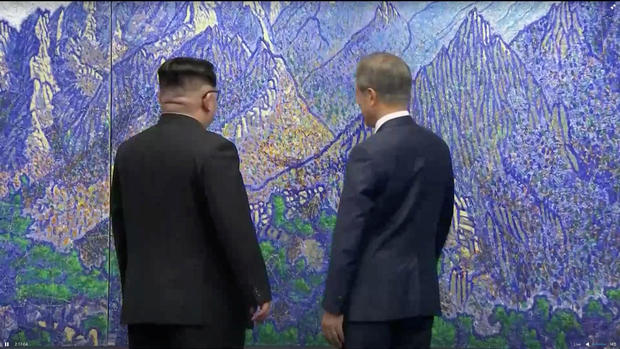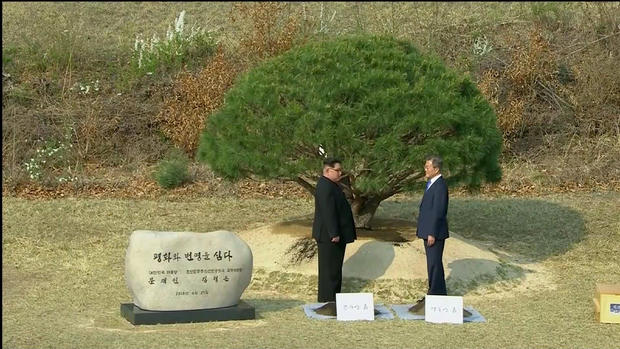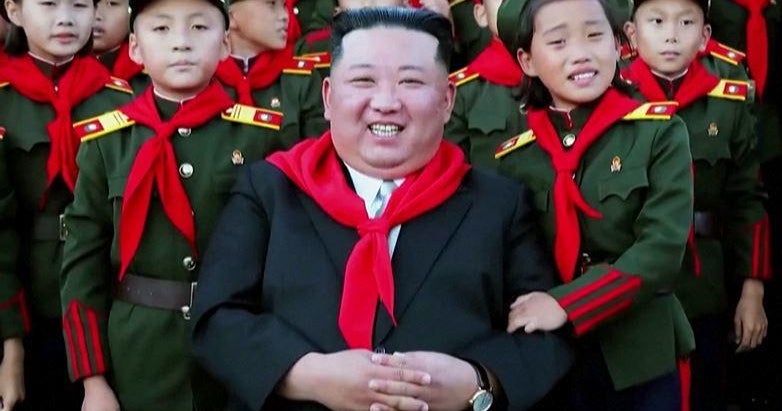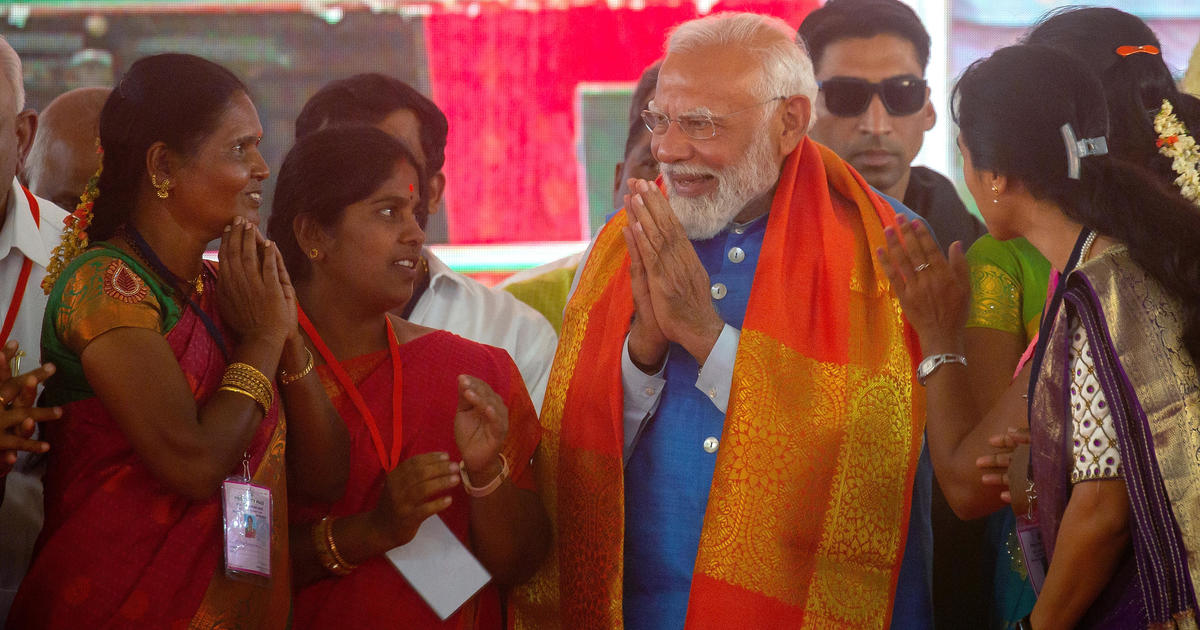Koreas agree to work toward "complete denuclearization"
GOYANG, South Korea -- With a single step over a weathered, cracked slab of concrete, North Korean leader Kim Jong Un made history Friday by crossing over the world's most heavily armed border to greet South Korean President Moon Jae-in for talks on North Korea's nuclear weapons. Kim then invited Moon to cross briefly back into the north with him before they returned to the southern side.
It was the first time a North Korean leader has crossed over to the southern side of the Demilitarized Zone since the Korean War armistice in 1953.
The two Koreas agreed during the historic summit to rid their peninsula of nuclear weapons, but they failed to provide any new specific measures on how to achieve that goal. A joint statement issued after the leaders' talks Friday said the two Koreas had confirmed their goal of achieving "a nuclear-free Korean Peninsula through complete denuclearization."
In what both sides referred to as the "Panmunjom Declaration," the Koreas agreed to an end goal of formally ending the Korean War with a peace treaty by the end of this year, and to immediately end all hostilities on the Korean Peninsula, involving trilateral or 4-way talks with the U.S. and China.
The entire summit must be seen in the context of the last year -- when the United States, its ally South Korea and the North seemed at times to be on the verge of nuclear war as the North unleashed a torrent of weapons tests - but also in light of the long, destructive history of the rival Koreas, who fought one of the 20th century's bloodiest conflicts and even today occupy a divided peninsula that's still technically in a state of war.
"I feel like I'm firing a flare at the starting line in the moment of (the two Koreas) writing a new history in North-South relations, peace and prosperity," Kim told Moon as they sat at a table, which had been built so that exactly 2018 millimeters separated them, to begin their closed-door talks. Moon responded that there were high expectations that they produce an agreement that will be a "big gift to the entire Korean nation and every peace-loving person in the world."
Beyond the carefully choreographed greeting, however, it's still not clear whether the leaders can make any progress in talks on the nuclear issue, which has bedeviled U.S. and South Korean officials for decades. North Korea's nuclear and missile tests last year likely put it on the threshold of becoming a legitimate nuclear power. North Korea claims it has already risen to that level.
Kim acknowledged the widespread skepticism: "We have reached big agreements before but were unable to fulfill them ... There are skeptical views on whether the meeting today will yield meaningful results," Kim said. "If we maintain a firm will and proceed forward hand in hand, it will be impossible at least for things to get worse than they are now."
The leaders had "sincere, candid" talks on the denuclearization of the Korean Peninsula and were working on the wording of a joint statement, according to Moon's spokesman, Yoon Young-chan. They also discussed ways to establish peace on the Korean Peninsula and improve ties.
Kim and Moon in their talks vowed to have more meetings, Yoon said, with Kim joking that he would make sure not to interrupt Moon's sleep anymore, a reference to the North's drumbeat of early morning missile tests last year.
Kim also referred to a South Korean island that North Korea attacked with artillery in 2010, killing four, saying the residents of Yeonpyeong Island who have been living in fear of North Korean artillery have high hopes the summit will help heal past scars.
Kim said he'd visit Seoul's presidential Blue House if invited.
Isaac Stone Fish, CBSN contributor and senior fellow at the Asia Society, put the summit in context.
"It's certainly incredibly significant to see these two men meeting with expectations of peace being so high," Fish said. "I think a lot of people have talked about the shift of where we are today and where we were several months ago. It's important to remember that even though the two leaders are smiling and posing with children ... it's very possible in a few months from now, tensions will go back to where they were."
"It's hard to know how much credit to give to (President) Trump's sanctions and his 'maximum pressure' policy and how much credit to give to Kim Jong Un -- the North Korean dictator feeling secure at home, feeling that he's consolidated enough power domestically, feeling that he now has enough of a nuclear weapons arsenal that he can negotiate -- if not from a position of strength -- a position that he's comfortable he'll be able to stay in power," Fish added.
Earlier, both leaders smiled broadly as Moon grasped Kim's hand and led him along a blindingly red carpet into South Korean territory, where schoolchildren gave Kim flowers and an honor guard stood at attention for inspection, a military band playing traditional Korean folk songs beloved by both Koreas and the South Korean equivalent of "Hail to the Chief."
The greeting of the two leaders was planned to the last detail. Thousands of journalists were kept in a huge conference center well away from the summit, except for a small group of tightly controlled pool reporters at the border. Moon stood near the Koreas' dividing line, moving forward the moment he glimpsed Kim, dressed in dark, Mao-style suit, appearing in front of a building on the northern side. They shook hands with the border line between them. Moon then invited Kim to cross into the South, and, after Kim did so, Moon said, "You have crossed into the South, but when do I get to go across?" Kim replied, "Why don't we go across now?" and then grasped Moon's hand and led him into the North and then back into the South. They took ceremonial photos facing the North and then facing the South.
Two fifth-grade students from the Daesongdong Elementary School, the only South Korean school within the DMZ, greeted the leaders and gave Kim flowers. Kim and Moon then saluted an honor guard and military band, and Moon introduced Kim to South Korean government officials. Kim returned the favor, introducing Moon to the North Korean officials accompanying him. They then took a photo inside the Peace House, where the summit was to take place, in front of a painting of South Korea's Bukhan Mountain, which towers over the South Korean Blue House presidential mansion. Kim's sister, Kim Yo Jong, was by his side throughout the ceremony, handing him a pen to sign a guestbook, taking the schoolchildren's flowers from his hand and scribbling notes at the start of the talks with Moon.
Nuclear weapons topped the agenda as the two leaders met, and Friday's summit will be the clearest sign yet of whether it's possible to peacefully negotiate those weapons away from a country that has spent decades doggedly building its bombs despite crippling sanctions and near-constant international opprobrium.
Expectations have been generally low, given that past so-called breakthroughs on North Korea's weapons have collapsed amid acrimonious charges of cheating and bad faith. Skeptics of engagement have long said that the North often turns to interminable rounds of diplomacy meant to ease the pain of sanctions - giving it time to perfect its weapons and win aid for unfulfilled nuclear promises.
Advocates of engagement, however, say the only way to get a deal is to do what the Koreas tried Friday: Sit down and see what's possible.
Tree planting
Kim and Moon appeared to be getting on amicably. After their first round of talks, the leaders emerged and jointly planted a pine tree, which stands for peace and prosperity, on the Military Demarcation Line (MDL), which has symbolized confrontation and division over the past 65 years.
The pine, a tree beloved by the Korean people, was selected as the species for the commemorative tree planting. The particular tree planted on Friday dates back to 1953, when the Korean War Armistice Agreement was signed. A mixture of soil from mountains in North and South was used in the planting, and Kim watered it with water from the Hangang river, while President Moon poured water from the Daedonggang River, symbolizing cooperation and harmony between the Koreas.
Engraved on the stone plaque which sits in front of the tree is the phrase "Peace and Prosperity Are Planted," as well as the signatures of both leaders.
The commemorative tree-planting event was suggested by the South Korean government and agreed to by the North, which also accepted the South's choice of tree species and wording for the stone plaque placed in front of the tree.
After the tree was planted and watered, the two leaders posed briefly for photos before engaging in a friendly chat as they walked together to a footbridge at the MDL.
The Footbridge got its name from the United Nations Command, when it was built over a marsh in the Panmunjeom area to shorten the route taken by the Neutral Nations Supervisory Commission, which frequently came to Panmunjeom after the Armistice Agreement was concluded. Work to widen and extend the bridge was taken as part of preparations for the 2018 Inter-Korean Summit.
The agreement
After the second and final round of closed-door talks, the leaders emerged again and sat together to sign a joint "Panmunjom Declaration" agreeing to work toward the "complete denuclearization of the Korean peninsula" and a formal end to the war.
Officially dubbed the Panmunjom Declaration for Peace, Prosperity, Unification of the Korean Peninsula, the agreement calls for both sides:
- To completely cease all hostile acts s on land, sea, air
- To transform the Demilitarized Zone into a "peace zone"
- To stop propaganda broadcasts, leafleting starting May 1
- Area near the western northern limit line to be turned into a maritime peace zone to prevent sudden naval clashes
- To hold military talks in May
After the signing ceremony both men walked outside together and gave remarks at side-by-side podiums. Moon said new offices would be established in both North and South Korea to facilitate economic cooperation, and a new liaison office in the Northern border city of Kaesong, where both sides would continue to hold meetings on denuclearization. Kaesong, a joint industrial complex that had workers from both sides of the border, was shuttered several years ago as tensions mounted anew.
Kim thanked Moon for hosting the summit, calling him "brother," and saying they had both realized "we cannot be separated. We are one nation."
Moon has agreed to visit North Korea's capital of Pyongyang this autumn for another round of talks.
U.S. hopes
The White House said in a statement prior to the summit that it was "hopeful that talks will achieve progress toward a future of peace and prosperity for the entire Korean Peninsula. ... (and) looks forward to continuing robust discussions in preparation for the planned meeting between President Donald J. Trump and Kim Jong Un in the coming weeks."
Moon, a liberal whose election last year ended a decade of conservative rule in Seoul, will be looking to make some headway on the North's nuclear program in advance of a planned summit in several weeks between Kim and Mr. Trump.
Kim, the third member of his family to rule his nation with absolute power, is eager, both in this meeting and in the Trump talks, to discuss the nearly 30,000 heavily armed U.S. troops stationed in South Korea and the lack of a formal peace treaty ending the Korea War - two factors, the North says, that make nuclear weapons necessary.
North Korea may also be looking to use the talks with Moon to set up the Trump summit, which it may see as a way to legitimize its declared status as a nuclear power.
One possible outcome Friday, aside from a rise in general goodwill between the countries, could be a proposal for a North Korean freeze of its weapons ahead of later denuclearization.
Seoul and Washington will be pushing for any freeze to be accompanied by rigorous and unfettered outside inspections of the North's nuclear facilities, since past deals have crumbled because of North Korea's unwillingness to open up to snooping foreigners.
South Korea has acknowledged that the most difficult sticking point between the Koreas has been North Korea's level of denuclearization commitment. Kim has reportedly said that he wouldn't need nuclear weapons if his government's security could be guaranteed and external threats were removed.
Whatever the Koreas announce Friday, the spectacle of Kim being feted on South Korean soil was striking.
Kim and Moon enjoyed each other's company in the jointly controlled village of Panmunjom near the spot where a defecting North Korean soldier fled south last year in a hail of bullets fired by his former comrades, and not too far where North Korean soldiers axe-murdered two U.S. soldiers in 1976.






